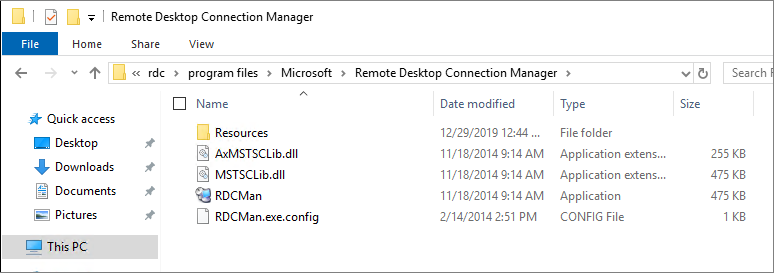 Installing Remote Desktop Connection Manager as limited user
Installing Remote Desktop Connection Manager as limited user
Installing the Remote Desktop Connection Manager requires administrator privileges. That can be a problem in a corporate environment where you might not have local administrator rights. Fortunately, there is an easy way to overcome this limitation by performing an administrative installation.
Administrative Installations
When you install an MSI package, you can tell msiexec to perform an administrative installation instead of a regular installation. During an administrative installation, msiexec extracts all files embedded in the MSI files, but does not apply any configuration changes that a regular installation would apply.
An administrative installation can serve multiple purposes, the most important being:
By serving the extracted files on a network share, client computers can perform installs, repairs, and reinstalls of the respective package without having to download the entire MSI over the network.
If the MSI is only a few MB in size, serving the extracted files might provide little advantage over simply putting the MSI file on the file share – but in the case of large MSI packages, being able to directly access selected files might speed up the installation process.
Today, even this speedup might be negligible. But back in the days when disk space was scarce, some MSI packages allowed certain features to be advertised only. These features were then installed on first use – and having a file share that contained the extracted installation media could make a real difference in how fast this on-demand installation could be performed.
Similar to advertising a feature, Windows Installer allows features to be run from source. In this case, the files are not copied to the local disk at all but read from the network share remotely every time they are needed. Again, the idea is to save disk space on the client computer.
Today, disk space is rarely an issue, so features like advertised installs and run from source have mostly lost their appeal. However, administrative installations are still a handy way to extract an MSI file. And for simple applications like the one for the Remote Desktop Connection Manager, extracting the MSI package is all that is needed to “install” the application without requiring administrative rights.
Installing Remote Desktop Connection Manager
Perform the following steps to install the Remote Desktop Connection Manager to your local user profile without administrative rights:
- Open a command prompt.
Create a new directory to install the Remote Desktop Connection Manager to:
md %APPDATA%\RDCMan && cd %APPDATA%\RDCManDownload the installer and save the MSI to the Downloads directory
Run the installer:
msiexec /A "%USERPROFILE%\Downloads\rdcman.msi" TARGETDIR="%APPDATA%\RDCMan" /l* install.log /QB!Notice the user of the following command line switches in the command:
/Ainstructs msiexec to perform an administrative installTARGETDIRspecifies the directory to extract files to/l*Enables logging/QB!Performs a GUI-less, silent installation
Now run the following command to view the extracted files:
explorer .\program files\Microsoft\Remote Desktop Connection ManagerNotice that all files have been extracted to the directory. You can now use RDCMan by running rdcman.exe.

Installing the Cloud IAP plugin
With the Remote Desktop Connection Manager installed, you can now install the Google Cloud IAP for Remote Desktop, again without administrative rights:
- Download the plugin and save the MSI to the Downloads directory
Run the installer and specify the installation directory of Remote Desktop Connection Manager as TARGETDIR:
msiexec /A "%USERPROFILE%\Downloads\CloudIap-Plugin-1.1.37.0.msi" TARGETDIR="%APPDATA%\RDCMan\program files\Microsoft\Remote Desktop Connection Manager" /l* plugin-install.log /QB!Now run the following command to view the extracted files:
explorer .\program files\Microsoft\Remote Desktop Connection ManagerNotice that all files have been extracted to the directory. You can now use the Remote Desktop Connection Manager with the Cloud IAP plugin by running rdcman.exe.
